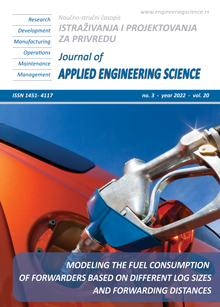APPLICATION OF THE CURLI METHOD FOR MULTI-CRITICAL DECISION OF GRINDING PROCESS
Abstract
In the case of highly precise flat surfaces, surface roughness and flatness tolerance (FL) play virtual roles and directly cause the performance of the parts. In general, both surface roughness and FL are required at the minimum value. Grinding is needed in order to finish the surface. However, sometimes in specific grinding conditions, this could not be achieved. Hence, it is imperative to select the grinding conditions that satisfy both parameters to be considered “minimum”. This problem is commonly known as multi-criteria decision making (MCDM). However, choose a method to determine the weights for the criteria sometimes makes the decision-makers confused because each method of determining the weights finds different sets of the weight values. Along with that, for each method of determining the weight, the ranking results of the alternatives may also be changed. Using an MCDM method without specifying weights for the criteria eliminates this problem. Collaborative Unbiased Rank List integration (CURLI) is one of the multi-criteria decision making methods that do not need to determine the weights for the criteria. In this research, we not only applying CURLI method to multi-criteria decision making, but also developing detailed steps to apply. This work has not been done before even for the authors who proposed it. Using this method for multi-criteria decision-making, the grinding process has determined the abrasive grain size, workpiece velocity, feed rate and depth of cut to ensure that the surface roughness and FL are kept to a minimum.
References
Trung, D. D. (2021). Application of TOPSIS an PIV methods for Multi - Criteria Decision Making in hard turning process. Journal of Machine Engineering, vol. 21, no. 4, 57-71, DOI: 10.36897/jme/142599
Nguyen, N. T., Trung, D. D. (2021). Combination of taguchi method, moora and copras techniques in multi-objective optimization of surface grinding process. Journal of Applied Engineering Science, vol. 19, no. 2, 390 – 398, DOI: 10.5937/jaes0-28702
Tien, D. H., Trung, D. D., Thien, N. V., Nguyen, N. T. Nguyen. Multi-Objective Optimization of the Cylindrical Grinding Process of SCM440 Steel Using Preference Selection Index Method. Journal of Machine Engineering, vol. 21, no. 3, 110-123,DOI: 10.36897/jme/141607
Trung, D. D., Thien, N. V., Nguyen N. T. (2021). Application of TOPSIS Method in Multi-Objective Optimization of the Grinding Process Using Segmented Grinding Wheel. Tribology in Industry, vol. 43, no. 1, 12-22, DOI: 10.24874/ti.998.11.20.12
Kusumadewi, S., Hartati, S., Harjoko, A., Wardoyo, R. (2006). Fuzzy Multi-Attribute Decision Making (FUZZY MADM). Yogyakarta: Penerbit Graha Ilmu.
Zavadskas, E. K., Turskis, Z., Antucheviciene, J., Zakarevicius, A. (2012). Optimization of weighted aggregated sum product assessment. Elektron ir elektrotechnika, vol. 122, no. 2012, 3-6
Hwang, C. L., Lai, Y. J. Ting,_Y. L. (1993). A new approach for multiple objective decision making. Computers & Operations Research, vol. 20, 889–899
Opricovic, S., Tzeng, G. H. (2004). Compromise solution by MCDM methods: A comparative analysis of VIKOR and TOPSIS. European Journal of Operational Research, vol. 156, 445-455.
Brauers, W. (2004). Optimization methods for a stakeholder society. A revolution in economic thinking by multi-objective optimization. Publisher: springer before Kluwer.
riantaphyllou, Evangelos. (2020). Multi-criteria Decision Making Methods: A Comparative Study, Springer – Science + Busines media.
Mufazzal, S., Muzakkir, S. M. (2008). A New Multi-Criterion Decision Making (MCDM) Method Based on Proximity Indexed Value for Minimizing Rank Reversals. Computers & Industrial Engineering, vol. 2008, 1-38.
Cables Perez, E., Lamata, M.T., Verdegay, J.L. (2016). RIM-Reference Ideal Method in
Multicriteria Decision Making. Information Sciences, vol. 337, no. 10, 1-10, DOI: 10.1016/j.ins.2015.12.011
Stevic, Z., Pamucar, D., Puska, A., Chatterjee, P. (2020). Sustainable supplier selection in healthcare industries using a new MCDM method: Measurement Alternatives and Ranking according to COmpromise Solution (MARCOS). Computers & Industrial Engineering, vol. 140, 1-33.
Ewa, R. (2013). Rank Ordering Criteria Weighting Methods – A Comparative Overview. Journal Dedicated to the Needs of Science and Practice, vol. 5, no. 65, 1–168, DOI: 10.15290/ose.2013.05.65.02
James, R. K., David, J. A. (2016). A new method for group decision making and its
application in medical trainee selection. Medical Education, vol. 50, 1045–1053,
DOI: 10.1111/medu.13112
Huang Y., Wang L., Steven, Y. L. (2019). Hanbook of manufacturing, World Scientific, 2019, DOI: 10.1142/11006
Varga, J., Teodor, T., Peter, F., Dulebov, L., Emil, S., Ivan, Z., Jozef, Z. (2011). The Influence of Automated Machining Strategy on Geometric Deviations of Machined Surfaces. Applied sciences, vol. 11, no. 2353, 1-15, DOI:.10.3390/app11052353
Drake, P. J. (1999). Dimensioning and Tolerancing Handbook, McGraw-Hill.
Hong, T. T., Giang, T. N., Vu. N. N., Danh, B. T., Tu, D, N., Dung, N. T. Q., Pi, V. N., Tung, L. A. (2021. Optimizing Dressing Conditions for Minimum Flatness Tolerance when Grinding SKD11 Tool Steel. Materials Science Forum, vol. 1020, 83-90, DOI: 10.4028/www.scientific.net/MSF.1020.83
Trung, D. D., Nguyen, N. T., Thien, N. V. (2021). Application of TOPSIS Method in Multi-Objective Optimization of the Grinding Process Using Segmented Grinding Wheel. Tribology in Industry, vol. 43, no. 1, 12-22, DOI: 10.24874/ti.998.11.20.12
Malkin, S., Guo, C. (2008). Grinding technology: Theory and Applications of Machining with Abrasives (2nd Edition). New York: Industrial Press.

